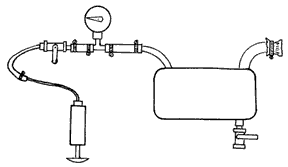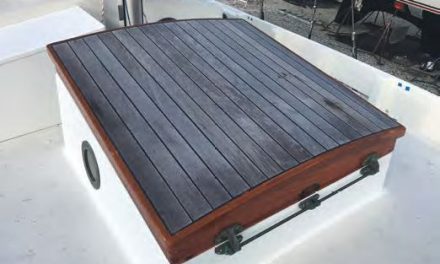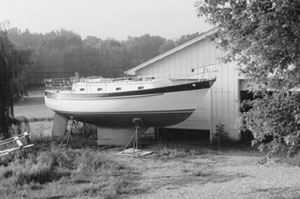 The epoxy “cure”
The epoxy “cure”
One of the most annoying problems that can occur on a sailboat is a leak in the diesel fuel tank. If you don’t have the time, expertise, or courage to attempt to repair it yourself, you can always arrange to have your boatyard repair it. But you can do it yourself, if you are willing to try.
If your boat is constructed so that tank removal is possible without major disassembly of the interior, make the repair with the tank removed. The repair will then be fairly straightforward. Since most diesel fuel tanks are made of aluminum or black iron, a welding shop can repair either material with relatively little expense. First remove the inspection cover and thoroughly clean the interior of the tank. While you’re at it, inspect it for pitting and other potential future problems. If the tank doesn’t have an inspection cover, now would be an excellent time to install one. If you ever get bad fuel or have a sludge buildup in your tank, you will be glad you have access to the interior of your tank to clean it.
If you cannot remove your tank or don’t have an inspection port, let me walk you through my experience in repairing the fuel tank on our boat Bluebonnet, a Valiant 32. During the second year of a multi-year refit I was doing on the boat in our back yard, I became aware that diesel fuel was seeping into the bilge. We had bought the boat in Texas and had it trucked to our home in Missouri, where I was repairing extensive blisters and bringing the boat back to her former glory.
At first I pushed the leak out of my mind, since I was involved with other work on the boat. However, when the smell wouldn’t go away I decided that it would have to be fixed. The Valiant 32 has a 47-gallon aluminum fuel tank that is mounted aft of the L-25 Westerbeke diesel engine under the cockpit sole. Due to its size, the only way to remove it would be to remove the engine first.
Even then, removing the tank would have been questionable because offshore sailboats tend to have small, narrow companionways. I decided to repair the tank in place. The first step was to empty the remaining fuel from the tank. This was accomplished by pumping the fuel into five-gallon cans.
Squeezing into the starboard cockpit locker, I found that I could lie next to the fuel tank and work. I had 10 to 12 inches of clearance between the top of the tank and the cockpit sole. In the flat area on the top of the tank, I cut a 10-inch square hole with a right-angle drill and a sabre saw to give access to the interior of the tank. If you have removed your tank and are installing an inspection port, make sure the location will be accessible when the tank is re-installed. I removed the fuel gauge sending unit and set it aside. Then I cleaned the inside of the tank using rags first and solvents later.
During this process, the engine access panels were removed and a high volume fan circulated air throughout the area. I wore a respirator at all times. There was evidence of pitting in the aluminum in the lowest part of the tank, and one of the largest pits was paper thin. To repair the leak, I called Gougeon Brothers of Bay City, Mich. For blister repair on the hull, I had been using their West System epoxy and fillers.
I had called them before with other questions and found them to be very cordial and knowledgeable. I was told that they had used epoxy to repair fuel tanks with excellent results and was given instructions about how to proceed. With special attention to the pitted areas, I gave the entire interior of the tank a final cleaning with acetone to remove any oily residue. I mixed some epoxy and hardener with some filler to make a putty the consistency of peanut butter. This was worked into the areas where the pitting had occurred. After this cured, I sanded the area smooth. Then I lightly sanded the entire area with number 100 emery cloth and wiped it down with acetone. Using a disposable brush, I coated the interior with epoxy and hardener.
I then purchased a piece of 3/16-inch thick aluminum, 12 x 12 inches. I drilled three holes on each side H inch in from the edge. I centered this plate over the hole, scribed the top of the tank, and center-punched the holes. Then I drilled holes and tapped the top of the tank for G x 20 aluminum bolts. Aluminum bolts were available, and I used them to prevent corrosion. I cut a piece of gasket material to size and fitted it. Before the cover was bolted in place, I checked the fuel gauge sending unit and verified that it was working, then I installed it and replaced its gasket. I bolted the cover in place and used an RTV gasket compound that I purchased at an auto parts store.
After two years of service, including a trip down the Tennessee-Tombigbee Waterway, I have been very pleased with the repair.
Article from Good Old Boat magazine, January/February 1999.





